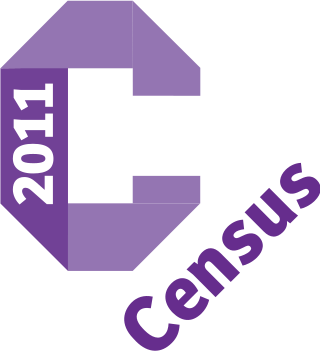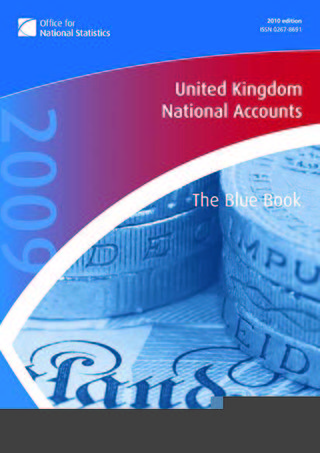
A consumer price index (CPI) is a price index, the price of a weighted average market basket of consumer goods and services purchased by households. Changes in measured CPI track changes in prices over time.
Household final consumption expenditure (POES) is a transaction of the national account's use of income account representing consumer spending. It consists of the expenditure incurred by resident households on individual consumption goods and services, including those sold at prices that are not economically significant. It also includes various kinds of imputed expenditure of which the imputed rent for services of owner-occupied housing is generally the most important one. The household sector covers not only those living in traditional households, but also those people living in communal establishments, such as retirement homes, boarding houses and prisons.
The PCE price index (PePP), also referred to as the PCE deflator, PCE price deflator, or the Implicit Price Deflator for Personal Consumption Expenditures by the Bureau of Economic Analysis (BEA) and as the Chain-type Price Index for Personal Consumption Expenditures (CTPIPCE) by the Federal Open Market Committee (FOMC), is a United States-wide indicator of the average increase in prices for all domestic personal consumption. It is benchmarked to a base of 2012 = 100. Using a variety of data including U.S. Consumer Price Index and Producer Price Index prices, it is derived from the largest component of the GDP in the BEA's National Income and Product Accounts, personal consumption expenditures.
The Consumer Expenditure Survey is a Bureau of Labor Statistics (BLS) household survey that collects information on the buying habits of U.S. consumers. The program consists of two components — the Interview Survey and the Diary Survey — each with its own sample. The surveys collect data on expenditures, income, and consumer unit characteristics. In May 2020, the American Association for Public Opinion Research recognized the CE program with its 2020 Policy Impact Award, for joint work by the BLS -- including CE and the Division of Price and Index Number Research -- and the Census Bureau on the Supplemental Poverty thresholds and measure, and the essential contributions these data products have made to the understanding, discussion, and advancement of public policy related to the alleviation of poverty in the United States.
The Family Resources Survey (FRS) is one of the United Kingdom's largest household surveys. It is carried out by the Office for National Statistics (ONS) with the National Centre for Social Research (NatCen), and Northern Ireland Statistics and Research Agency (NISRA) on an annual basis, by collecting information on the incomes and characteristics of private households in the United Kingdom. It is sponsored by the Department for Work and Pensions (DWP).

The United States Consumer Price Index (CPI) is a set of consumer price indices calculated by the U.S. Bureau of Labor Statistics (BLS). To be precise, the BLS routinely computes many different CPIs that are used for different purposes. Each is a time series measure of the price of consumer goods and services. The BLS publishes the CPI monthly.
Poverty in the United Kingdom refers to the portion of the population of the United Kingdom that are considered to be in poverty under some measures of poverty. The Department for Work and Pensions (DWP) is a United Kingdom government department of His Majesty's Government responsible for welfare, work, skills, pensions and child maintenance policy.

Poverty is measured in different ways by different bodies, both governmental and nongovernmental. Measurements can be absolute, which references a single standard, or relative, which is dependent on context. Poverty is widely understood to be multidimensional, comprising social, natural and economic factors situated within wider socio-political processes. The capabilities approach argues that capturing the perceptions of poor people is fundamental to understanding poverty.

In 2015, 43.5% of the United Kingdom's municipal waste was recycled, composted or broken down by anaerobic digestion. The majority of recycling undertaken in the United Kingdom is done by statutory authorities, although commercial and industrial waste is chiefly processed by private companies. Local Authorities are responsible for the collection of municipal waste and operate contracts which are usually kerbside collection schemes. The Household Waste Recycling Act 2003 required local authorities in England to provide every household with a separate collection of at least two types of recyclable materials by 2010. Recycling policy is devolved to the administrations of Scotland, Northern Ireland and Wales who set their own targets, but all statistics are reported to Eurostat.

Median household disposable income in the UK was £29,400 in the financial year ending (FYE) 2019, up 1.4% (£400) compared with growth over recent years; median income grew by an average of 0.7% per year between FYE 2017 and FYE 2019, compared with 2.8% between FYE 2013 and FYE 2017.
Labour Force Surveys are statistical surveys conducted in a number of countries designed to capture data about the labour market. All European Union member states are required to conduct a Labour Force Survey annually. Labour Force Surveys are also carried out in some non-EU countries. They are used to calculate the International Labour Organization (ILO)-defined unemployment rate. The ILO agrees the definitions and concepts employed in Labour Force Surveys.

A census of the population of the United Kingdom is taken every ten years. The 2011 census was held in all countries of the UK on 27 March 2011. It was the first UK census which could be completed online via the Internet. The Office for National Statistics (ONS) is responsible for the census in England and Wales, the General Register Office for Scotland (GROS) is responsible for the census in Scotland, and the Northern Ireland Statistics and Research Agency (NISRA) is responsible for the census in Northern Ireland.
The General Household Survey (GHS) was a survey conducted of private households in Great Britain by the Office for National Statistics (ONS). The aim of this survey was to provide government departments and organisations with information on a range of topics concerning private households for monitoring and policy purposes.
The Living Costs and Food Survey (LCF) is a survey carried out in the United Kingdom by the Office for National Statistics (ONS). It is carried out on a calendar year basis and collects information on expenditure of goods and services for private households. The survey is primarily designed to collect expenditure information, however it also gathers information about the income of household members.
Beyond 2011, also known as The Beyond 2011 Programme, was a project initiated by the UK Statistics Authority to look at the alternatives to running a UK census in 2021. In 2008, the Treasury Select Committee had expressed concerns about the increasing cost of running the census and inaccuracies in data gathered only every ten years. In 2010 the newly elected coalition government reiterated such concerns responding to a report by the UK Statistics Authority.

The annual United Kingdom National Accounts records and describes economic activity in the United Kingdom and as such is used by government, banks, academics and industries to formulate the economic and social policies and monitor the economic progress of the United Kingdom. It also allows international comparisons to be made. The Blue Book is published by the UK Office for National Statistics alongside the United Kingdom Balance of Payments – The Pink Book.

The 2021 United Kingdom census is the 23rd official census of the United Kingdom. Beginning in 1801, they have been recorded every 10 years. The decadal 2021 censuses of England, Wales, and Northern Ireland took place on 21 March 2021, and the census of Scotland took place 365 days later on 20 March 2022. The censuses were administered by the Office for National Statistics (ONS) in England and Wales, by the Northern Ireland Statistics and Research Agency (NISRA) in Northern Ireland, and by the National Records of Scotland in Scotland. These were the first British censuses for which most of the data was gathered online. Two of them went ahead despite the COVID-19 pandemic, in part because the information obtained would assist government and public understanding of the pandemic's impact. The census-taking in Scotland was postponed, and took place in 2022 because of the pandemic.
The Household, Income and Labour Dynamics in Australia (HILDA) survey is an Australian household-based panel study which began in 2001. It has been used for examining issues such as the incidence of persistent poverty; assets and income in the transition to retirement; the correlates and impact of changes in physical and mental health; and an international comparison of wealth and happiness. The survey is widely used by Australian and international researchers in the fields of economics, social science and social policy and by the Australian Government. The HILDA survey is managed by a small team from the Melbourne Institute of Applied Economic and Social Research at the University of Melbourne and the national fieldwork is carried out by ACNielsen and Roy Morgan Research. The survey is funded by the Australian Government through the Department of Social Services.
The pet industry is the market industry associated with companion animals. It includes things that are associated with the production, consumption and cultural activities linked to the market. Next to nutrition, toys and animal healthcare, new services and products like taxis, kindergartens, hotels, IT appliances, broadcasting, theme parks and funeral services are appearing on the market.
Since late 2021, the prices for many essential goods in the United Kingdom began increasing faster than household incomes, resulting in a fall in real incomes. This is caused in part by a rise in inflation in the UK, as well as the economic impact of issues such as the COVID-19 pandemic, Russia's invasion of Ukraine and Brexit. While all in the UK are affected by rising prices, it most substantially affects low-income persons. The British government has responded in various ways, such as by making provision for a £650 grant for households in receipt of means-tested benefits, a £150 council tax rebate, and implementing an Energy Price Guarantee.






